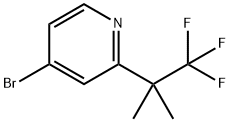Synthesis

To a solution of 18-6 (8.7 g, 42.40 mmol, 1 eq) in 1,2-dichloroethane (90 mL) was added Phosphorus(V) oxybromide (18.23 g, 63.60 mmol, 6.47 mL, 1.5 eq). The mixture was stirred at 80°C for 4 hours. TLC (Petroleum ether: Ethyl acetate: Ethanol =4:3:1) showed a part of starting material was remained. Another Phosphorus (V) oxybromide (6.08 g, 21.20 mmol, 2.16 mL, 0.5 eq) was added into the mixture. The reaction mixture was stirred at 80°C for another 3 hours. TLC (Petroleum ether: ethyl acetate: ethanol=4:3:1) showed the starting material was consumed completely. The mixture was combined with another batch (1 g scale) and then poured into ice saturated sodium bicarbonate solution (300 mL) and adjust the pH=7~8. The mixture was extracted with ethyl acetate (100 mLx3). The combined organic layers were washed with brine (100 mL), dried over anhydrous sodium sulfate, filtered, concentrated in vacuum. The residue was purified by column chromatography (SiO2, Petroleum ether: ethyl acetate=1:0 to 50:11) to give 18-7 (8.5 g, 31.71 mmol, 67.37% yield, 100% purity) as light yellow oil.
Synthesis
4-broMo-2-(1,1,1-trifluoro-2-Methylpropan-2-yl)pyridine can be used as organic synthesis intermediate and pharmaceutical intermediate, mainly used in laboratory research and development process and chemical production process.

